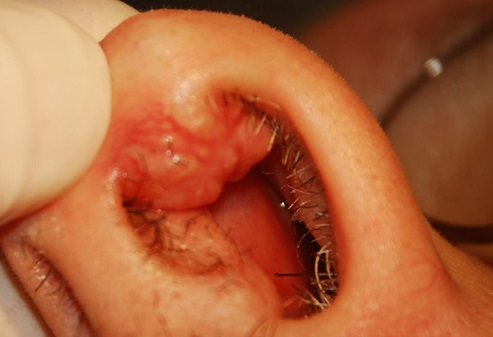Nikhil Prasad Fact checked by:Thailand Medical News Team Nov 07, 2024 5 months, 6 days, 50 minutes ago
Medical News: A recent study has shed light on an unusual form of nasal growths known as sinonasal exophytic papillomas (SNEP). These benign tumors, which occur in the nasal cavities, are classified into two types: focal (FSNEP), with a single localized growth, and diffuse (DSNEP), where growth is spread across multiple areas in the nasal passages. Researchers from institutions such as the Catalan Institute of Oncology, Bellvitge Biomedical Research Institute, and the University of Barcelona in Spain, have taken an in-depth look into the factors linked to the diffuse spread of these tumors.
 HPV-Linked Benign Nasal Tumors
HPV-Linked Benign Nasal Tumors
The investigation explored how age, HPV infection, and tumor location might contribute to the difference between localized and widespread nasal papillomas. This
Medical News report delves into how viral presence, particularly of HPV types 6 and 11, plays a crucial role in DSNEP and may explain why certain cases are more complex and recurrent.
Study Approach
The study analyzed medical records from 18 patients with diagnosed sinonasal exophytic papillomas. Researchers performed tests on tissue samples to detect the presence of HPV DNA and measure the viral load, focusing on strains HPV6 and HPV11. HPV testing was crucial, as previous studies linked certain HPV strains to papillomas and warts. The goal was to determine if patients with widespread DSNEP had different viral loads or HPV strains than those with FSNEP.
Findings on Age and Recurrence Rates
The study revealed some clear distinctions between FSNEP and DSNEP patients. Those with diffuse DSNEP were generally younger, averaging around 43 years, compared to the FSNEP group, which averaged 65 years. Additionally, DSNEP patients faced higher recurrence rates, with almost 86% experiencing tumor regrowth, often within just five months. In contrast, FSNEP patients showed a much lower recurrence rate of 20%, with the few relapses occurring nearly five years after initial treatment.
HPV Presence and Types
One of the most striking findings was the connection between HPV infection and DSNEP. While HPV was detected in 75% of all patients, 100% of DSNEP cases tested positive for HPV DNA, with most infections linked to the HPV11 strain. Only 40% of FSNEP cases showed HPV presence, primarily with HPV6. This correlation suggests that DSNEP could be significantly more likely in individuals with HPV11, potentially due to the virus’s increased ability to promote tumor spread in nasal tissues.
Tumor Location and Symptoms
DSNEP also showed a strong tendency to appear in the nasal septum, affecting over 85% of these cases. In contrast, FSNEP was more likely to occur on the lateral walls of the nasal cavity. Common symptoms included nasal obstruction and, occasionally, nosebleeds or sinus infections. However, these symptoms were not exclusive to DSNEP or FSNEP, which made clinical diagnosis challenging without detailed testing.
Viral Load as a Predictive Factor
In DSNEP cas
es, the study found higher viral loads of HPV11 compared to HPV6. This difference in viral load could indicate that HPV11, at higher quantities, may drive a more aggressive and recurrent form of DSNEP. Although previous studies on respiratory papillomas suggested a link between high viral loads and recurrent growth, the link in nasal papillomas requires further research. However, these findings suggest that monitoring viral load could help predict disease progression in DSNEP.
Conclusion
The study concludes that DSNEP is more common in younger patients, often involves the nasal septum, and is strongly associated with HPV infection, especially HPV11. These diffuse papillomas are more likely to recur, necessitating close monitoring and potentially alternative treatments to reduce recurrence rates. As researchers continue to explore the role of HPV in sinonasal papillomas, these findings could lead to new diagnostic and treatment options for patients suffering from recurrent, diffuse nasal tumors.
The study findings were published in the peer-reviewed Journal of Clinical Medicine.
https://www.mdpi.com/2077-0383/13/22/6638
For the latest on HPV and Cancer, keep on logging to Thailand
Medical News.
Read Also:
https://www.thailandmedical.news/news/microbes-may-fuel-nasal-tumors
https://www.thailandmedical.news/news/thailand-medical-researchers-discover-that-ellagic-acid-can-help-against-hpv-infections-in-women
https://www.thailandmedical.news/news/breaking-hpv-news-one-in-three-men-worldwide-are-infected-with-hpv-virus-which-is-also-an-oncovirus-and-worrisome-in-covid-19-era
https://www.thailandmedical.news/news/medical-controversy:-are-hpv-vaccines-really-effective-as-all-past-studies-had-methodological-flaws
https://www.thailandmedical.news/news/is-merck-s-gardasil-hpv-vaccine-triggering-cervical-cancer-instead-of-preventing-it-numerous-legal-suits-filed-against-merck-emerging-data-is-worrisom
https://www.thailandmedical.news/news/incidences-of-anal-cancer-on-the-rise-while-many-are-ignorant-about-hpv-links-to-it
https://www.thailandmedical.news/news/males-contracting-hpv-linked-head-and-neck-cancer-on-an-exponential-rise-thanks-to-porn-and-oral-sex
https://www.thailandmedical.news/news/most-people-not-aware-about-hpv-or-its-cancer-causing--effects-despite-hpv-related-cancers-increasing-worldwide-
https://www.thailandmedical.news/news/hpv-or-papillomavirus-could-be-contracted-by-blood-transfusions
